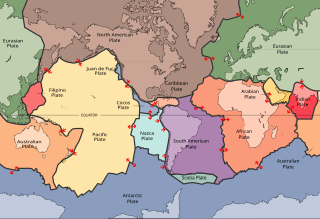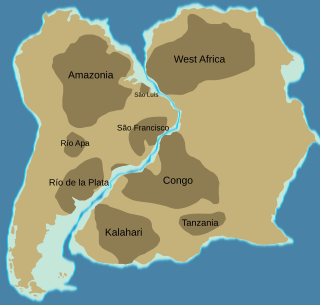Related Research Articles

A lithosphere is the rigid, outermost rocky shell of a terrestrial planet or natural satellite. On Earth, it is composed of the crust and the lithospheric mantle, the topmost portion of the upper mantle that behaves elastically on time scales of up to thousands of years or more. The crust and upper mantle are distinguished on the basis of chemistry and mineralogy.

The asthenosphere is the mechanically weak and ductile region of the upper mantle of Earth. It lies below the lithosphere, at a depth between ~80 and 200 km below the surface, and extends as deep as 700 km (430 mi). However, the lower boundary of the asthenosphere is not well defined.

Subduction is a geological process in which the oceanic lithosphere and some continental lithosphere is recycled into the Earth's mantle at convergent boundaries. Where the oceanic lithosphere of a tectonic plate converges with the less dense lithosphere of a second plate, the heavier plate dives beneath the second plate and sinks into the mantle. A region where this process occurs is known as a subduction zone, and its surface expression is known as an arc-trench complex. The process of subduction has created most of the Earth's continental crust. Rates of subduction are typically measured in centimeters per year, with rates of convergence as high as 11 cm/year.

Post-glacial rebound is the rise of land masses after the removal of the huge weight of ice sheets during the last glacial period, which had caused isostatic depression. Post-glacial rebound and isostatic depression are phases of glacial isostasy, the deformation of the Earth's crust in response to changes in ice mass distribution. The direct raising effects of post-glacial rebound are readily apparent in parts of Northern Eurasia, Northern America, Patagonia, and Antarctica. However, through the processes of ocean siphoning and continental levering, the effects of post-glacial rebound on sea level are felt globally far from the locations of current and former ice sheets.
Tectonophysics, a branch of geophysics, is the study of the physical processes that underlie tectonic deformation. This includes measurement or calculation of the stress- and strain fields on Earth’s surface and the rheologies of the crust, mantle, lithosphere and asthenosphere.

A craton is an old and stable part of the continental lithosphere, which consists of Earth's two topmost layers, the crust and the uppermost mantle. Having often survived cycles of merging and rifting of continents, cratons are generally found in the interiors of tectonic plates; the exceptions occur where geologically recent rifting events have separated cratons and created passive margins along their edges. Cratons are characteristically composed of ancient crystalline basement rock, which may be covered by younger sedimentary rock. They have a thick crust and deep lithospheric roots that extend as much as several hundred kilometres into Earth's mantle.

Continental crust is the layer of igneous, metamorphic, and sedimentary rocks that forms the geological continents and the areas of shallow seabed close to their shores, known as continental shelves. This layer is sometimes called sial because its bulk composition is richer in aluminium silicates (Al-Si) and has a lower density compared to the oceanic crust, called sima which is richer in magnesium silicate (Mg-Si) minerals. Changes in seismic wave velocities have shown that at a certain depth, there is a reasonably sharp contrast between the more felsic upper continental crust and the lower continental crust, which is more mafic in character.

Oceanic crust is the uppermost layer of the oceanic portion of the tectonic plates. It is composed of the upper oceanic crust, with pillow lavas and a dike complex, and the lower oceanic crust, composed of troctolite, gabbro and ultramafic cumulates. The crust overlies the rigid uppermost layer of the mantle. The crust and the rigid upper mantle layer together constitute oceanic lithosphere.

A mid-ocean ridge (MOR) is a seafloor mountain system formed by plate tectonics. It typically has a depth of about 2,600 meters (8,500 ft) and rises about 2,000 meters (6,600 ft) above the deepest portion of an ocean basin. This feature is where seafloor spreading takes place along a divergent plate boundary. The rate of seafloor spreading determines the morphology of the crest of the mid-ocean ridge and its width in an ocean basin.
Carmen Gaina is the Director of the Centre for Earth Evolution and Dynamics (CEED) a Norwegian Centre of Excellence hosted at the Department of Geosciences, University of Oslo, Norway.

In geology, the slab is a significant constituent of subduction zones.

Crustal recycling is a tectonic process by which surface material from the lithosphere is recycled into the mantle by subduction erosion or delamination. The subducting slabs carry volatile compounds and water into the mantle, as well as crustal material with an isotopic signature different from that of primitive mantle. Identification of this crustal signature in mantle-derived rocks is proof of crustal recycling.

A tessera is a region of heavily deformed terrain on Venus, characterized by two or more intersecting tectonic elements, high topography, and subsequent high radar backscatter. Tesserae often represent the oldest material at any given location and are among the most tectonically deformed terrains on Venus's surface. Diverse types of tessera terrain exist. It is not currently clear if this is due to a variety in the interactions of Venus's mantle with regional crustal or lithospheric stresses, or if these diverse terrains represent different locations in the timeline of crustal plateau formation and fall. Multiple models of tessera formation exist and further extensive studies of Venus's surface are necessary to fully understand this complex terrain.
Ridge push is a proposed driving force for plate motion in plate tectonics that occurs at mid-ocean ridges as the result of the rigid lithosphere sliding down the hot, raised asthenosphere below mid-ocean ridges. Although it is called ridge push, the term is somewhat misleading; it is actually a body force that acts throughout an ocean plate, not just at the ridge, as a result of gravitational pull. The name comes from earlier models of plate tectonics in which ridge push was primarily ascribed to upwelling magma at mid-ocean ridges pushing or wedging the plates apart.
Heat-pipe tectonics is a cooling mode of terrestrial planets and moons in which the main heat transport mechanism in the planet is volcanism through the outer hard shell, also called the lithosphere. Heat-pipe tectonics initiates when volcanism becomes the dominant surface heat transfer process. Melted rocks and other more volatile planetary materials are transferred from the mantle to surface via localised vents. Melts cool down and solidify forming layers of cool volcanic materials. Newly erupted materials deposit on top of and bury older layers. The accumulation of volcanic layers on the shell and the corresponding evacuation of materials at depth cause the downward transfer of superficial materials such that the shell materials continuously descend toward the planet's interior.
Stanley Robert Hart is an American geologist, geochemist, leading international expert on mantle isotope geochemistry, and pioneer of chemical geodynamics.
Karen Fischer is an American seismologist known for her research on the structure of Earth's mantle, its lithosphere, and how subduction zones change over geologic history.
Anne Sheehan is a geologist known for her research using seismometer data to examine changes in the Earth's crust and mantle.
Roger Clive Searle is an English geophysicist, known for using sonar imaging in research on the geology and geophysics of the ocean floor. In particular, he has made important contributions to understanding the oceanic spreading system and the mid-ocean spreading centres.
Donald "Don" William Forsyth is an American geophysicist and seismologist, known for his research on the oceanic lithosphere and the oceanic aesthenosphere.
References
- ↑ "Greg Hirth". Department of Earth, Environtal and Planetary Sciences (DEEPS), Brown University. (home page)
- 1 2 3 4 5 6 7 8 "Greg Hirth, Curriculum Vitae" (PDF). Brown University.
- 1 2 3 4 Forsyth, Donald. "2018 George P. Willard Award, Presented to Greg Hirth". The Geological Society of America.
- 1 2 "Greg Hirth". OCEANUS, The Journal of Our Ocean Planet. Woods Hole Oceanographic Institution.
- ↑ Kelemen, Peter B.; Braun, Michael; Hirth, Greg (2000). "Spatial distribution of melt conduits in the mantle beneath oceanic spreading ridges: Observations from the Ingalls and Oman ophiolites". Geochemistry, Geophysics, Geosystems. 1 (7): 1005. Bibcode:2000GGG.....1.1005K. doi: 10.1029/1999GC000012 . S2CID 128772321. (See list of ophiolites.)
- ↑ Mehl, Luc; Hacker, Bradley R.; Hirth, Greg; Kelemen, Peter B. (2003). "Arc‐parallel flow within the mantle wedge: Evidence from the accreted Talkeetna arc, south central Alaska". Journal of Geophysical Research: Solid Earth. 108 (B8): 2375. Bibcode:2003JGRB..108.2375M. doi:10.1029/2002JB002233.
- ↑ Keller, C. Brehnin (6 October 2023). "Talkeetna Arc, Alaska".
- ↑ Hirth, Greg; Kohlstedt, David L. (1996). "Water in the oceanic upper mantle: Implications for rheology, melt extraction and the evolution of the lithosphere". Earth and Planetary Science Letters. 144 (1–2): 93–108. Bibcode:1996E&PSL.144...93H. doi:10.1016/0012-821X(96)00154-9.
- ↑ Kelemen, Peter B.; Hirth, Greg (2007). "A periodic shear-heating mechanism for intermediate-depth earthquakes in the mantle". Nature. 446 (7137): 787–790. Bibcode:2007Natur.446..787K. doi:10.1038/nature05717. PMID 17429398. S2CID 4340739.
- ↑ Okazaki, Keishi; Hirth, Greg (2016). "Dehydration of lawsonite could directly trigger earthquakes in subducting oceanic crust". Nature. 530 (7588): 81–84. Bibcode:2016Natur.530...81O. doi:10.1038/nature16501. PMID 26842057. S2CID 4453183.
- ↑ Tsai, Victor C.; Hirth, Greg (2020). "Elastic Impact Consequences for High‐Frequency Earthquake Ground Motion". Geophysical Research Letters. 47 (5). Bibcode:2020GeoRL..4786302T. doi: 10.1029/2019GL086302 . S2CID 216314139.
- ↑ Tsai, Victor C.; Hirth, Greg; Trugman, Daniel T.; Chu, Shanna X. (2021). "Impact Versus Frictional Earthquake Models for High‐Frequency Radiation in Complex Fault Zones". Journal of Geophysical Research: Solid Earth. 126 (8). Bibcode:2021JGRB..12622313T. doi:10.1029/2021JB022313. S2CID 237723389.
- ↑ Hirth, Greg; Tullis, Jan (1994). "The brittle‐plastic transition in experimentally deformed quartz aggregates". Journal of Geophysical Research: Solid Earth. 99 (B6): 11731–11747. Bibcode:1994JGR....9911731H. doi:10.1029/93JB02873.
- ↑ Hirth, Greg; Kohlstedt, David L. (1995). "Experimental constraints on the dynamics of the partially molten upper mantle: Deformation in the diffusion creep regime". Journal of Geophysical Research: Solid Earth. 100 (B2): 1981–2001. Bibcode:1995JGR...100.1981H. doi: 10.1029/94JB02128 .
- ↑ Hirth, Greg; Kohlstedt, David L. (1995). "Experimental constraints on the dynamics of the partially molten upper mantle: 2. Deformation in the dislocation creep regime". Journal of Geophysical Research: Solid Earth. 100 (B8): 15441–15449. Bibcode:1995JGR...10015441H. doi:10.1029/95JB01292.
- ↑ Behn, Mark D.; Hirth, Greg; Elsenbeck Ii, James R. (2009). "Implications of grain size evolution on the seismic structure of the oceanic upper mantle". Earth and Planetary Science Letters. 282 (1–4): 178–189. Bibcode:2009E&PSL.282..178B. doi:10.1016/j.epsl.2009.03.014. hdl: 1912/2859 .
- ↑ Jaroslow, G.E.; Hirth, G.; Dick, H.J.B. (1996). "Abyssal peridotite mylonites: Implications for grain-size sensitive flow and strain localization in the oceanic lithosphere". Tectonophysics. 256 (1–4): 17–37. Bibcode:1996Tectp.256...17J. doi:10.1016/0040-1951(95)00163-8.
- ↑ Kidder, Steven; Hirth, Greg; Avouac, Jean-Philippe; Behr, Whitney (2016). "The influence of stress history on the grain size and microstructure of experimentally deformed quartzite". Journal of Structural Geology. 83: 194–206. Bibcode:2016JSG....83..194K. doi: 10.1016/j.jsg.2015.12.004 .
- ↑ Evans, R. L.; Lizarralde, D.; Collins, J.; Hirth, G.; Gaherty, J. "Structure of the Oceanic Mantle: Geophysical Constraints on Lithosphere Evolution" (PDF). DefLAB Workshop, Dublin Institute for Advanced Studies, June 2009 (invited). DefLAB
- ↑ Escartín, J.; Hirth, G.; Evans, B. (2001). "Strength of slightly serpentinized peridotites: Implications for the tectonics of oceanic lithosphere". Geology. 29 (11): 1023. Bibcode:2001Geo....29.1023E. doi:10.1130/0091-7613(2001)029<1023:SOSSPI>2.0.CO;2. ISSN 0091-7613.
- ↑ Ito, Garrett; Shen, Yang; Hirth, Greg; Wolfe, Cecily J. (1999). "Mantle flow, melting, and dehydration of the Iceland mantle plume". Earth and Planetary Science Letters. 165 (1): 81–96. Bibcode:1999E&PSL.165...81I. doi:10.1016/S0012-821X(98)00216-7.
- ↑ "2017 Fall Meeting - T34A: Birch Lecture". YouTube ; lecture by Greg Hirth on December 13, 2017
{{cite web}}: CS1 maint: postscript (link) - ↑ "Hirth, John Price, 1930-". American Institute of Physics (AIP).
- ↑ "John P. Hirth". Member Directory, National Academy of Sciences.
- ↑ "Ann Mulligan – WHOI People Directory". Woods Hole Oceanographic Institution.
- ↑ "Luc Mehl". Mountaineers Books.
- ↑ "An Interview with Luc Mehl". A.M.H. Fine Mountain Equipment since 1974.
- ↑ "Luc Mehl channel". YouTube .
- ↑ "Things To Luc At, Wilderness Safety & Alaskan Advencture".